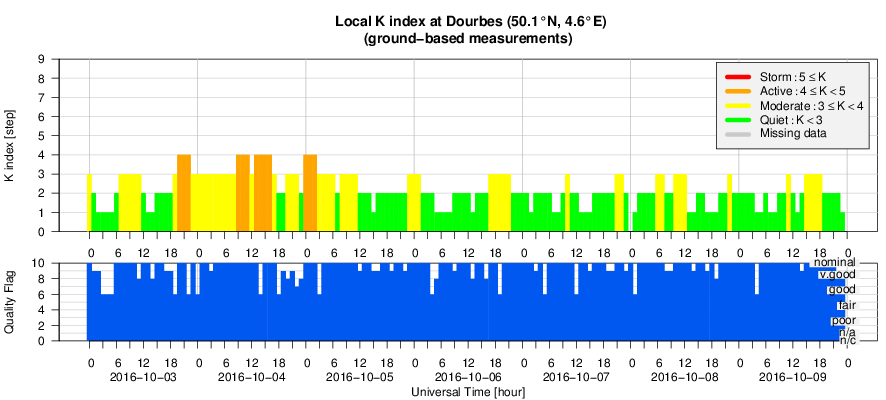- Table of Content
- 1.ASGARD: balloo...
- 2.PROBA2 Observa...
- 3.Review of sola...
- 4.The Internatio...
- 5.Review of geom...
- 6.Geomagnetic Ob...
- 7.Review of iono...
- 8.Future Events
2. PROBA2 Observations (3 Oct 2016 - 9 Oct 2016)
3. Review of solar activity
4. The International Sunspot Number
5. Review of geomagnetic activity
6. Geomagnetic Observations at Dourbes (3 Oct 2016 - 9 Oct 2016)
7. Review of ionospheric activity (3 Oct 2016 - 9 Oct 2016)
8. Future Events
ASGARD: balloons for science
For several years now, the Planetarium (Heysel) and the Space Pole (Uccle) host the ASGARD project (http://www.esero.be/_WP/?page_id=218 ) from ESERO Belgium and St-Pieterscollege Jette. Student teams think of their own scientific experiment to send to the stratosphere (near-space) with a stratospheric balloon from the Royal Meteorological Institute (RMI). The conditions are similar to being on the surface of Mars. Teams whose proposals are selected by the jury, can then build their experiment for real, presenting it to the other selected participants, and launch it in Brussels. During launch day, the students also have the opportunity to participate in several workshops and visit some of the facilities of the 3 institutes at the Space Pole.
This educationally all-inclusive project is open to all students from European secondary schools, and even two projects from Belgian primary schools will be selected (see the separate webpage at http://www.esero.be/_WP/?page_id=190 ). In 2016, 12 projects got a green light, with participating schools from Belgium, Italy, Spain and Poland.
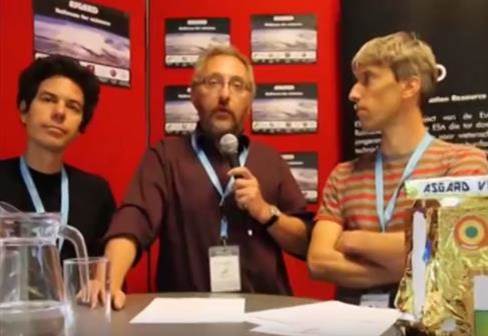
Three key persons are coordinating this project: Pieter Mestdagh (Planetarium, ESERO Belgium), Erik de Schrijver (Sint-Pieterscollege, Jette) and Roeland Van Malderen (RMI). They created a movie using footage from the previous years to explain the project and all ongoing activities. The movie can be found at https://www.youtube.com/watch?v=Z2ely2uvawA , with subtitles available in the 3 languages. A separate page with more info on the project is available at http://www.esero.be/_WP/?page_id=218 (EN), at http://www.esero.be/_WP/?page_id=190 (NL), and at http://www.esero.be/FR/?page_id=153 (FR).
At the same time, the movie is also being used to kick off the 2017 edition. First deadline is 11 November 2016, when all proposals should be submitted. There's plenty of room for your idea underneath that balloon!
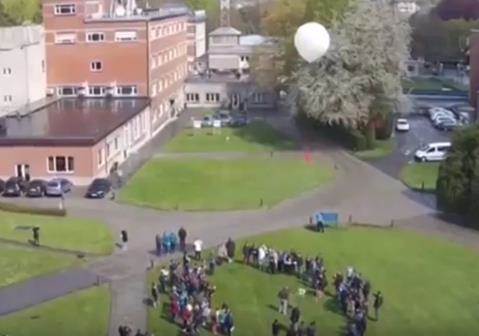
PROBA2 Observations (3 Oct 2016 - 9 Oct 2016)
Solar Activity
Solar flare activity fluctuated remained very low during the week.
In order to view the activity of this week in more detail, we suggest to go to the following website from which all the daily (normal and difference) movies can be accessed: http://proba2.oma.be/ssa
This page also lists the recorded flaring events.
A weekly overview movie can be found here (SWAP week 341).
proba2.oma.be/swap/data/mpg/movies/weekly_movies/weekly_movie_2016_10_03.mp4
Details about some of this week's events, can be found further below.
If any of the linked movies are unavailable they can be found in the P2SC movie repository here
http://proba2.oma.be/swap/data/mpg/movies/
Monday Oct 03
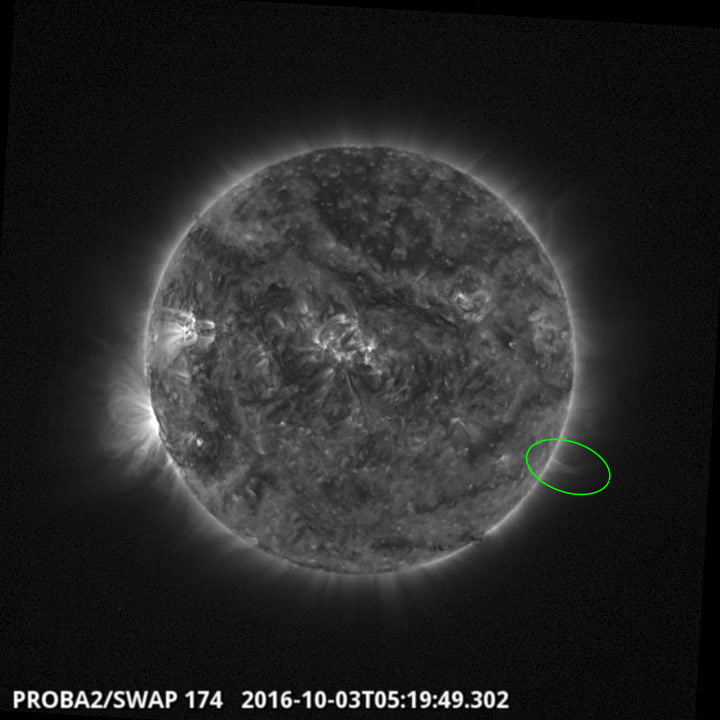
An eruption was observed by SWAP on the west limb of the Sun on 2016-Oct-03 at 05:19 UT
Find a movie of the event here (SWAP movie)
http://proba2.oma.be/swap/data/mpg/movies/20161003_swap_movie.mp4
Review of solar activity
Solar activity was low. The largest flare recorded was a B6.1 class flare. Active Region (AR) 2598 has been the most active one producing several B class flares, including the B6.1 flare on 04-Oct-2016 peaking at 04:09 UT.
The blue line in the graph below reflects on the X-ray flux and is clearly bounded in the B-level.
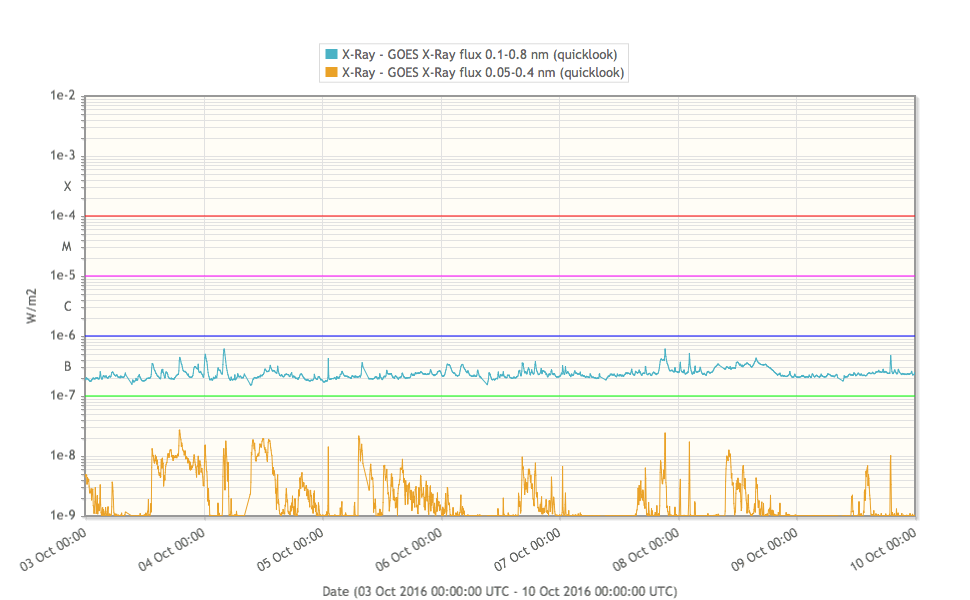
Solar protons have remained at background levels over the past week.
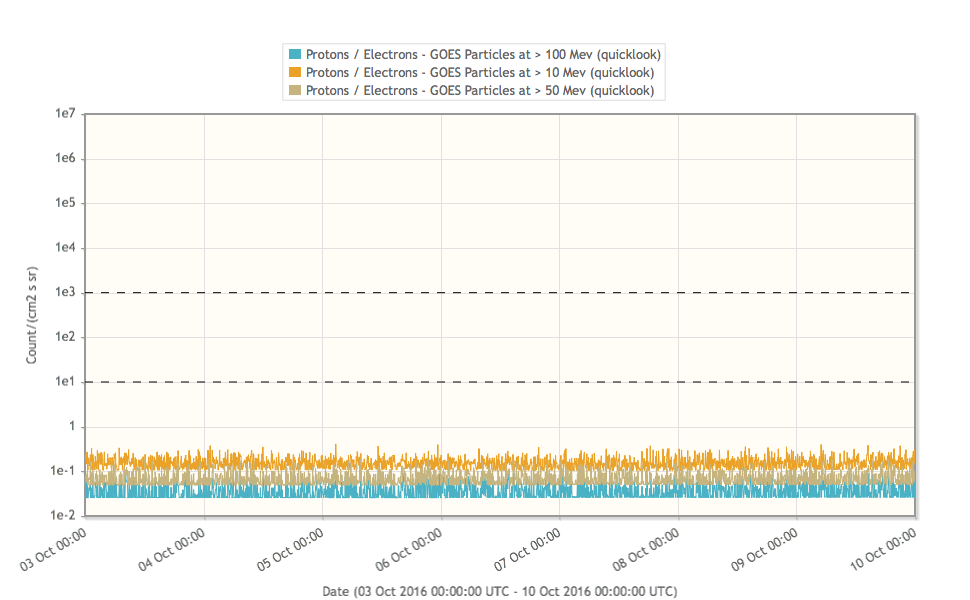
One faint Halo CME was detected from 02:00 UT onwards on 09-Oct-2016. The ejection was mostly directed towards the North-East and has an angular extent of 360 degrees. The speed was estimated to be around 300 km/s. Earth was likely to be located at the edge of the CME passage. And it was. On 12-Oct, 1 day earlier than expected, the CME passed Earth. In the DSCORV satellite data, even a shock was visible. More next week.
The International Sunspot Number
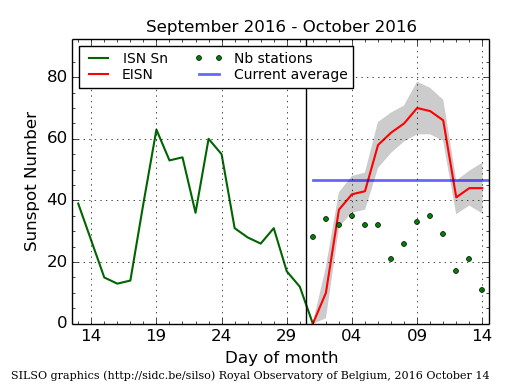
The daily Estimated International Sunspot Number (EISN, red curve with shaded error) derived by a simplified method from real-time data from the worldwide SILSO network. It extends the official Sunspot Number from the full processing of the preceding month (green line). The plot shows the last 30 days (about one solar rotation). The horizontal blue line shows the current monthly average, while the green dots give the number of stations included in the calculation of the EISN for each day.
Review of geomagnetic activity
The solar wind speed has fluctuated between 370 and 550 km/s over the past week. The graph below shows ACE data, a satellite in the L1 point. The straight lines denote data gaps.
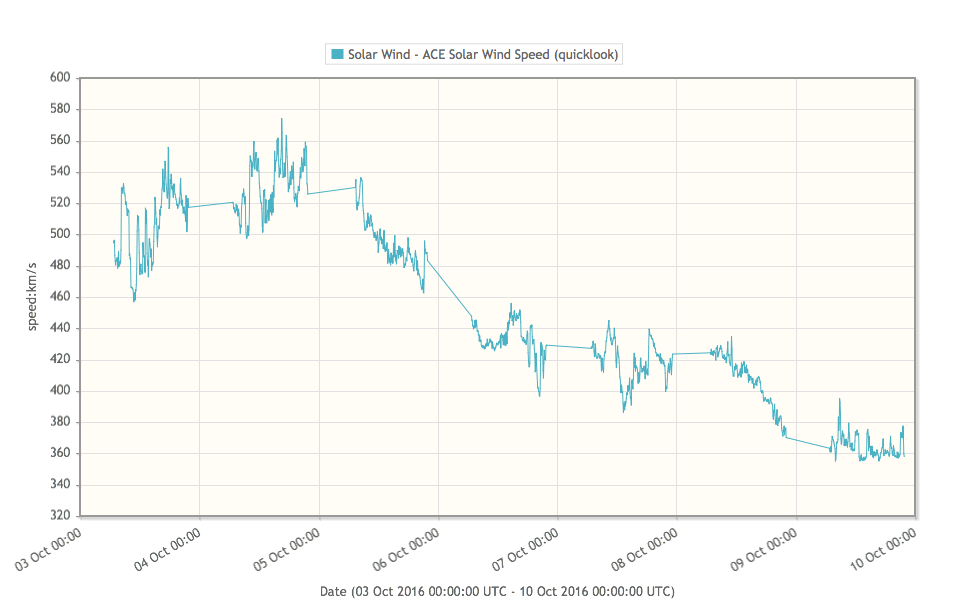
The total magnetic field strength has fluctuated between 3 and 10 nT peaking on 04-Oct-2016. The Bz component fluctuated between -6 and +9 nT. Again, the graph below shows ACE data.
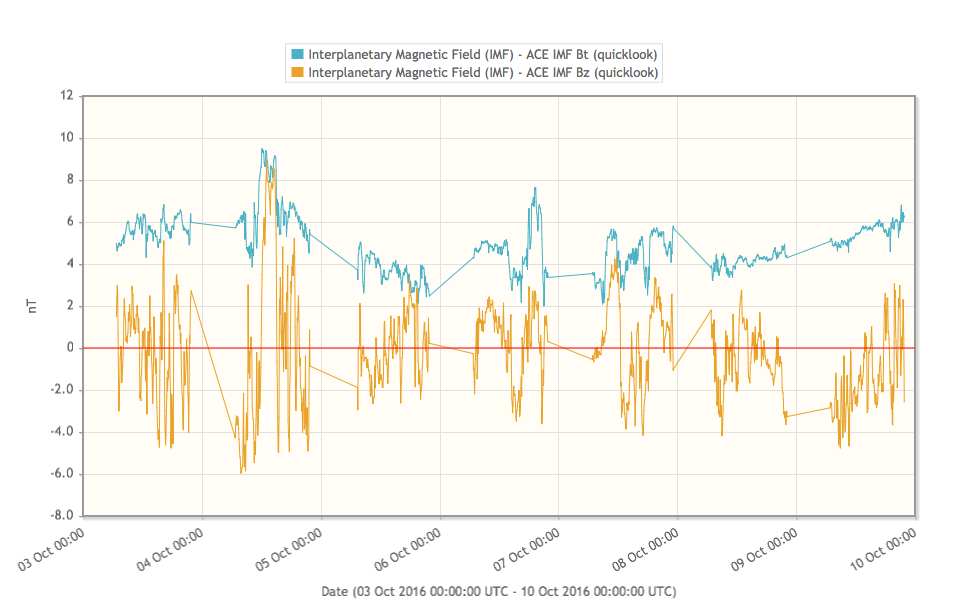
Geomagnetic conditions ranged between Kp index 1-5 (NOAA) and local K index 0-4 (Dourbes) over the past week, but largely remained around the 2 and 3 levels.
Review of ionospheric activity (3 Oct 2016 - 9 Oct 2016)
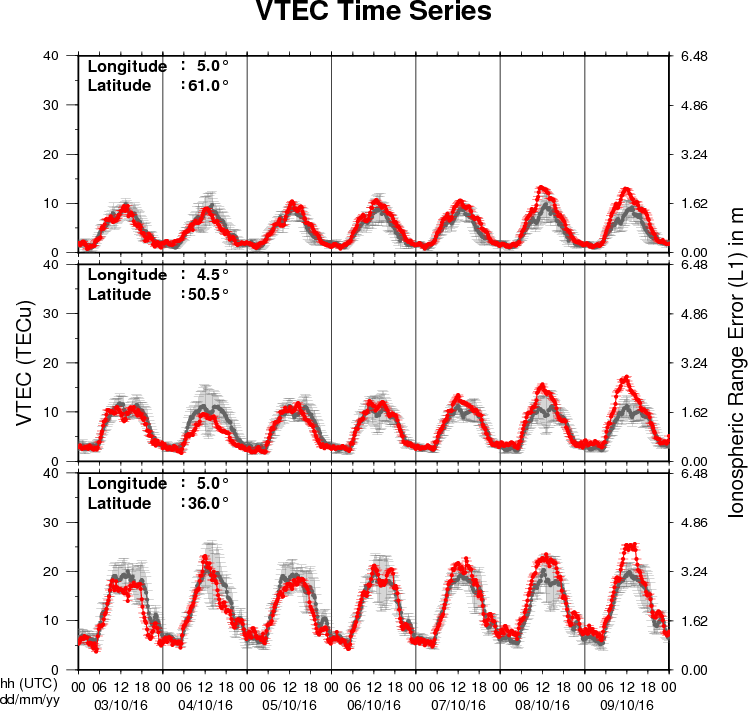
The figure shows the time evolution of the Vertical Total Electron Content (VTEC) (in red) during the last week at three locations:
a) in the northern part of Europe(N61°, 5°E)
b) above Brussels(N50.5°, 4.5°E)
c) in the southern part of Europe(N36°, 5°E)
This figure also shows (in grey) the normal ionospheric behaviour expected based on the median VTEC from the 15 previous days.
The VTEC is expressed in TECu (with TECu=10^16 electrons per square meter) and is directly related to the signal propagation delay due to the ionosphere (in figure: delay on GPS L1 frequency).
The Sun's radiation ionizes the Earth's upper atmosphere, the ionosphere, located from about 60km to 1000km above the Earth's surface.The ionization process in the ionosphere produces ions and free electrons. These electrons perturb the propagation of the GNSS (Global Navigation Satellite System) signals by inducing a so-called ionospheric delay.
See http://stce.be/newsletter/GNSS_final.pdf for some more explanations ; for detailed information, see http://gnss.be/ionosphere_tutorial.php
Future Events
For more details, see http://www.spaceweather.eu/en/event/future
4th Asia Oceania Space Weather Alliance (AOSWA) Workshop, in Jeju, Republic of Korea
Start : 2016-10-24 - End : 2016-10-27
Website:
http://aoswa4.spaceweather.org/index.php
Global Modelling of the Space Weather Chain in Helsinki, Finland
Start : 2016-10-24 - End : 2016-10-28
This event brings together solar, heliospheric, magnetospheric,
and ionospheric communities to discuss the current state and future
challenges in global modelling of the entire space weather chain.
Major developments in forecasting space weather, and understanding
the effects of solar eruptions requires increased communication and
collaboration of these often rather distinct communities. We
welcome submissions from these modelling communities and also
synergetic studies utilising both observations and numerical
models.
Website:
https://pnst.ias.u-psud.fr/sites/pnst/files/global_modelling_space_weather_oct2016.pdf
European Space Weather Week in Ostend, Belgium
Start : 2016-11-14 - End : 2016-11-18
The ESWW is the main annual event in the European Space Weather
calendar. It is the European forum for Space Weather as proven by
the high attendance to the past editions. The agenda will be
composed of plenary/parallel sessions, working meetings and
dedicated events for service end-users. The ESWW will again adopt
the central aim of bringing together the diverse groups in Europe
working on different aspects of Space Weather.
Website:
http://www.stce.be/esww13/
4th SOLARNET Meeting: The Physics of the Sun from the Interior to the Outer Atmosphere, in Lanzarote (Spain)
Start : 2017-01-16 - End : 2017-01-20
The IV SOLARNET MEETING 'The physics of the Sun from the
interior to the outer atmosphere' will take place in Lanzarote
(Spain) from 16th to 20th of January 2017, organized by the
Instituto de AstrofÃsica de Canarias (IAC).
SOLARNET (High-resolution Solar Physics Network) is an EU-FP7
project coordinated by IAC with the aim of bringing together and
integrating the major European research infrastructures in the
field of high-resolution solar physics. SOLARNET involves all
pertinent European research institutions, infrastructures, and data
repositories. Networking activities, access to first-class
infrastructures and joint research and development activities are
being covered under SOLARNET to improve, in quantity and quality,
the service provided by this European community.
The purpose of this conference is to provide a coherent picture
of the Sun as a single physical system playing all the underlying
physical processes measured and observed in the solar atmosphere to
date.
Website:
http://www.iac.es/congreso/solarnet-4meeting/
Solar Orbiter Workshop 7: Exploring the solar environs in Granada, Spain
Start : 2017-04-03 - End : 2017-04-06
This event will be hosted by the Instituto de Astrofisica de
Andalucia - CSIC. Please mind that on April 7th the 20th SWT
meeting will take place at the same venue.
Website: Unkown
